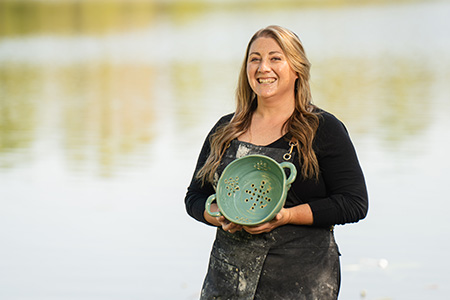Lisa's Story
Nurse practitioner finds alternative treatment to thyroid nodule through RFA procedure
 Lisa Smith, a wife, mother and nurse practitioner, had a history of abnormal thyroid labs since she was pregnant with her son around eight years ago. She also had a family history of thyroid disease, so when it was found that she had a nodule on her thyroid that was causing it to be hyperactive, she was not surprised.
Lisa Smith, a wife, mother and nurse practitioner, had a history of abnormal thyroid labs since she was pregnant with her son around eight years ago. She also had a family history of thyroid disease, so when it was found that she had a nodule on her thyroid that was causing it to be hyperactive, she was not surprised.
Lisa’s hyperactive thyroid caused her bloodwork to be abnormal, her heartrate was elevated, and she found it difficult to maintain her weight.
Feeling hesitant
For several years, Lisa was hesitant to undergo treatment for her overactive thyroid.
“Being a nurse practitioner, I know of the medications that can be taken or radiation procedures that can be done for removing a thyroid nodule. I know they’re safe and effective, but I didn’t want to be on any medications long-term and I didn’t feel comfortable removing my nodule with radiation. I was stubborn for a few years avoiding getting it removed,” recalled Lisa.
A new treatment option
 One day, at a routine appointment to check her thyroid, Lisa’s endocrinologist, Dr. Rebecca Simon, explained to her a new procedure called thyroid radiofrequency ablation (RFA). Dr. Simon referred Lisa to otolaryngologist Dr. Shivangi Lohia to perform the RFA procedure.
One day, at a routine appointment to check her thyroid, Lisa’s endocrinologist, Dr. Rebecca Simon, explained to her a new procedure called thyroid radiofrequency ablation (RFA). Dr. Simon referred Lisa to otolaryngologist Dr. Shivangi Lohia to perform the RFA procedure.
During RFA, your doctor uses a radiofrequency generator and allows a carefully controlled amount of energy to flow through the electrode into the tissue to treat (ablate) the nodule. With the sustained RFA thermal heat, the nodule is broken down and gets smaller in size.
“RFA is a great, minimally invasive treatment option for patients that don’t want surgery, radiation or long-term medications. Lisa was different from several of my other patients because she had a very large nodule on her thyroid that was causing pressure on her neck and overproduction of hormones. She had an elevated heartrate, and her labs were quite abnormal,” recalled Dr. Lohia, “In some cases we have to perform the RFA procedure multiple times in order to get thyroid levels back in a normal range, but in Lisa’s case her lab work was back to normal after just one procedure.”
The adjustment period
Lisa got the RFA procedure done in July of 2024 and recalled, “The procedure took about an hour and then I went home. It was very minimal, and I was awake and able to talk during it. For the following few months, I could tell my thyroid was adjusting. I became anemic and fatigued easily. Now my thyroid levels have leveled out and they’re back to normal for the first time in eight years and I’m feeling a lot better.”
Lisa is a mom, dog mom and avid potter. She has been a nurse practitioner for ten years and her husband is a physician. She explained that with her and her husband working in healthcare, she puts a lot more time, thought and research into making medical decisions than the average person would.
“I knew the risk factors of any way I chose to treat this thyroid nodule,” said Lisa, “The entire team was great from start to finish and I am so glad that RFA was a treatment option for me.”
er care team at Henry Ford.
.svg?iar=0&hash=F6049510E33E4E6D8196C26CCC0A64A4)

/hfh-logo-main--white.svg?iar=0&hash=ED491CBFADFB7670FAE94559C98D7798)